Are you planning a trip through the western United States? Then, under no circumstances should you pass by the canyon, considered by many to be the most beautiful place on Earth.
The Grand Canyon in northern Arizona is a gorge that has become one of the most iconic symbols of American nature. It’s called the Grand Canyon for a reason—this gorge is the largest river canyon in the world (though not the deepest, as that record belongs to the Colca Canyon in Peru). The Grand Canyon stretches for a massive 277 miles (447 km) in length, reaching up to 18 miles (29 km) wide at its broadest point, and plunging to a depth of 6,093 feet (1,857 meters) at its deepest spot, known as the Granite Gorge. These awe-inspiring dimensions draw around 4 million visitors from all over the world each year.
How Was the Grand Canyon Formed?
The story of the Grand Canyon begins around six million years ago, with the primary architect being the Colorado River, which runs through it. The natural movement of tectonic plates created the Colorado Plateau, and the river gradually eroded the land, carving out the spectacularly deep canyon that is today one of the top travel dreams for millions of globetrotters. This process continues even now, with natural forces constantly working to deepen and widen the Grand Canyon.
The fight to recognize special status for the Grand Canyon began as early as 1880, but it wasn’t until February 26, 1919, that then-President Woodrow Wilson signed the bill granting the Grand Canyon the status of a national park. In 1979, the park was added to the UNESCO World Heritage List.
In 2008, in response to the creation of a list of the New Seven Wonders of the World and with the aim of preserving the planet’s natural beauty, the Seven Natural Wonders of the World list was established. The Grand Canyon earned a spot on this prestigious list, alongside other global icons like Mount Everest and the Great Barrier Reef.
Geology of the Grand Canyon
The Grand Canyon’s vertical walls provide a clear geological cross-section of the Earth’s history. The oldest layers, formed first, are naturally found at the lowest levels. One of the most famous among them is the Vishnu Schist, which is one of the oldest rock formations in the canyon, dating back around 1.8 billion years, representing more than one-third of the Earth’s age! Above these ancient metamorphic rocks, you can see layers of sedimentary rocks, some of which still contain small fossils of plants or shells, offering a window into the distant past.
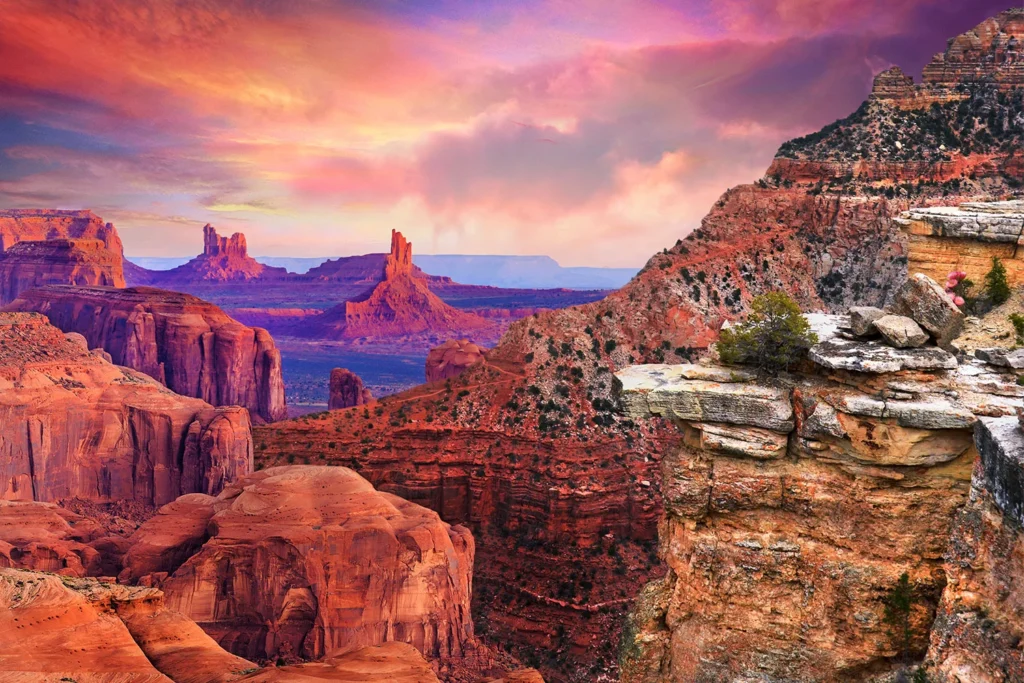
Grand Canyon – South Rim
The Grand Canyon is typically divided into two main areas: the South Rim and the North Rim. The South Rim is the most popular and tourist-friendly section of the canyon. It’s open year-round and well-prepared to accommodate millions of visitors. The Grand Canyon Visitor Center, located near Grand Canyon Village, serves as the primary hub for tourists. Around both the village and the visitor center, you’ll find ample parking as well as all the information necessary to help you plan your tour of the park.
Exploring the South Rim of the Grand Canyon
One of the most popular ways to explore the South Rim, especially for those who prefer a less physically demanding experience, is by taking advantage of the free shuttle bus service. Simply park your car in any available lot, hop on one of the buses that depart every 15 minutes, and enjoy the breathtaking views of the canyon as you make your way through numerous scenic stops.
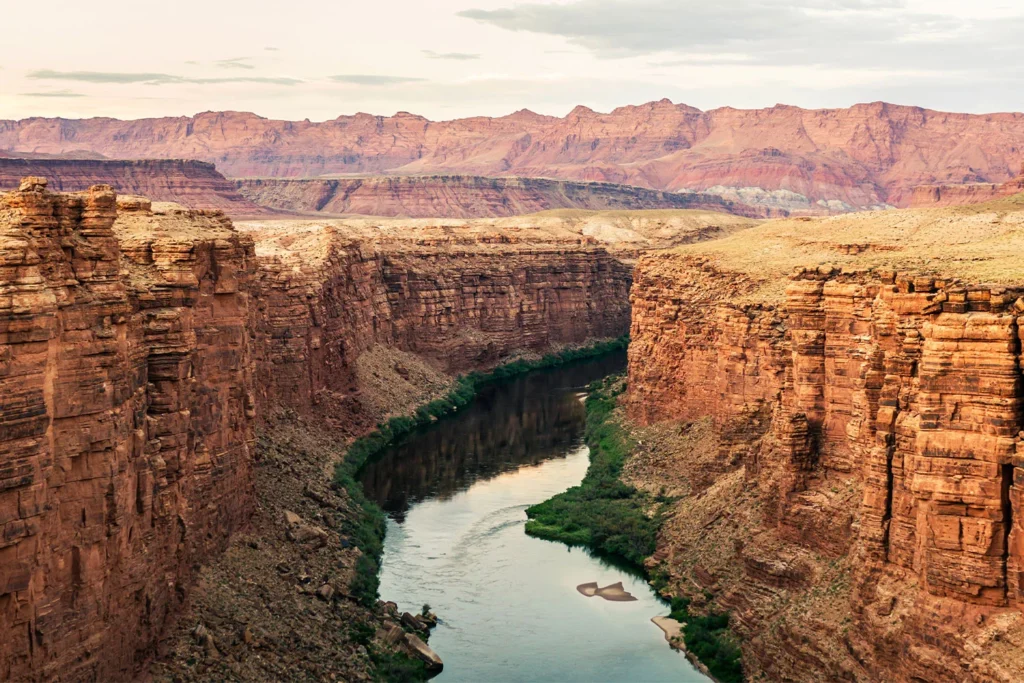
If you only have time or energy for a short walk, the Rim Trail is a great option. This 2-kilometer path runs along the edge of the canyon from Grand Canyon Village to the popular Mather Point, located right next to the visitor center. Although this trail is likely to be crowded with tourists, it offers a chance to observe the diverse geology of the canyon. A good alternative to taking the shuttle bus for the full trip is to ride it one way and then walk back to your car. You could stop at notable spots like the Yavapai Observation Station or Pipe Creek Vista.
For those looking to experience the Grand Canyon in a more serene environment, consider one of the longer trekking routes, such as the popular Bright Angel Trail or the Bridge Loop.
Grand Canyon – North Rim
The North Rim of the Grand Canyon is known for being wilder and arguably more scenic. It attracts only a small percentage of visitors, making it much quieter and less crowded. However, this part of the canyon is not accessible year-round, as it typically closes from mid-October to mid-May due to weather conditions, including snow.
Exploring the North Rim
If you prefer less-traveled paths and plan your trip to Arizona during the summer season, the North Rim will likely be a perfect fit for you. Most tours of the North Rim begin at the Grand Canyon Lodge, which is the only lodging facility in this section of the park and also serves as the visitor center.
A must-see on the North Rim is the short 15-minute walk to Bright Angel Point, one of the most popular viewpoints. Take some time here to admire the stunning views and capture some great photos. From Bright Angel Point, you can opt for a shorter 2-hour walk along the Transept Trail or immerse yourself deeper into the canyon by hiking the longer Widforss Trail. For the best sunrise, head to Point Imperial, the highest point on the North Rim at 2,683 meters, and for a spectacular sunset, visit Cape Royal.
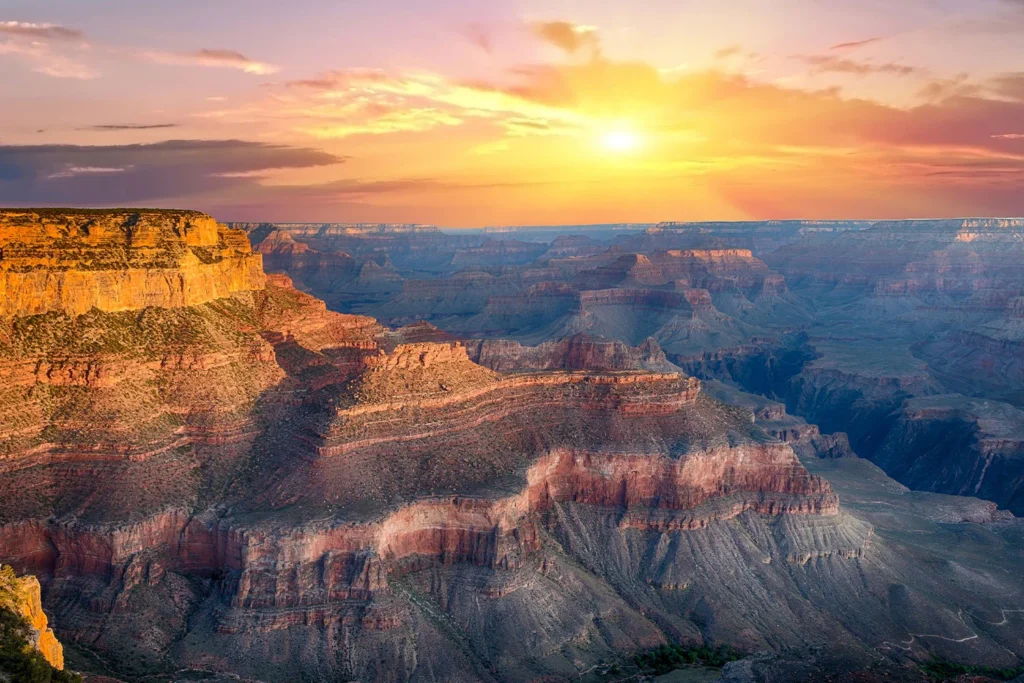
Not trekking enthusiasts but still dream of being mesmerized by the Grand Canyon’s scenery? Then consider a road trip, making stops at all the key viewpoints and picnic spots along the way.
GOOD TO KNOW: To switch between the canyon’s rims, you need to cross the Navajo Bridge, located near the town of Page. However, driving from the South Rim to the North Rim is quite a journey, covering over 350 km (around 220 miles). This road trip will take approximately 5 hours of driving.
Can you hike down into the canyon?
Yes, you can. If your trip focuses on the North Rim, you can explore the North Kaibab Trail, while from the South Rim, you can take the South Kaibab Trail. However, be cautious—this is not a hike for beginners. These trails are steep and extremely challenging, requiring you to overcome a 1,000-meter elevation difference. The difficulty is especially pronounced during the hot summer days. Before entering the trail, you’ll likely notice signs warning against planning the hike for a single day. The warnings also highlight the limited availability of drinking water on the trail and the potential for dizziness, fainting, or vomiting due to exhaustion. These cautionary signs tend to deter those who impulsively decide to trek down to the riverbed.
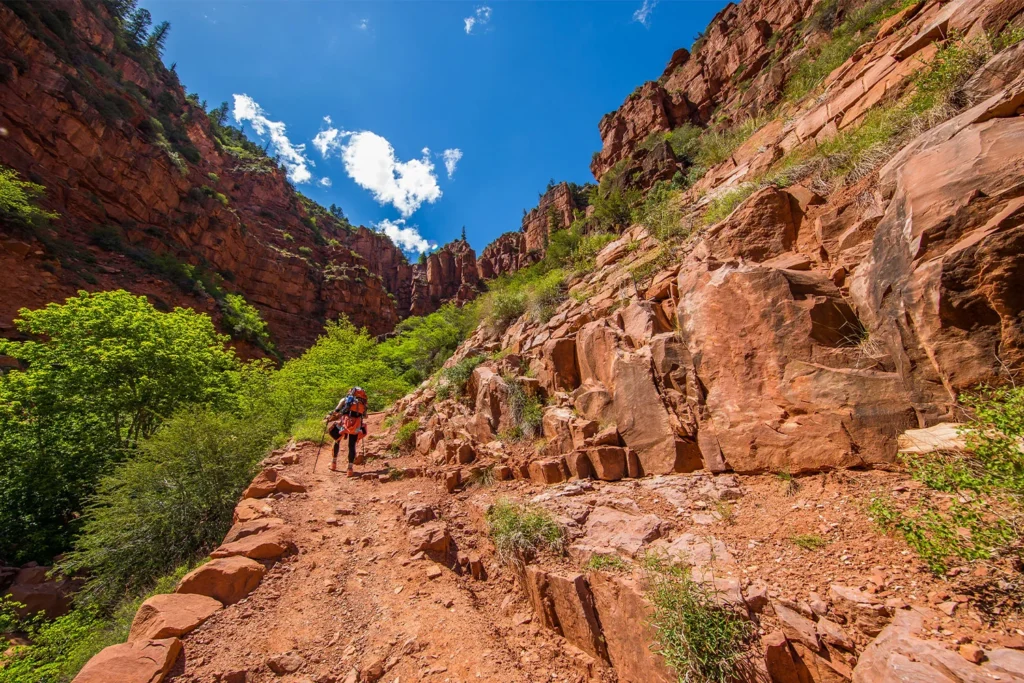
That doesn’t mean such an adventure is impossible. If you’re aware of your body’s limits and capabilities and still choose to take on this long hike, the effort will certainly be rewarded with breathtaking views and the satisfaction of reaching the bottom of the canyon. Be sure to wear your most comfortable hiking boots, put on a hat, and fill your backpack with plenty of water bottles.
Not Just Hiking
Looking for a unique experience at the Grand Canyon? You don’t have to commit to long or strenuous hikes. There are plenty of thrilling activities offered within the park. You can see the Grand Canyon from the sky by booking a helicopter or airplane tour, or stay on land and hop on the Grand Canyon Railway or rent a bike for a scenic ride. If you’re more into water-based adventures, rafting on the Colorado River is an exhilarating option. With the right permits, you can even go fishing in the river for an unforgettable outdoor experience.
A Home for Indigenous Peoples
The area of the Grand Canyon has been home to Native Americans since time immemorial. Even today, it remains a site of immense cultural and spiritual significance for the indigenous peoples of the western United States. The Grand Canyon National Park is associated with 11 Native American tribes, who collaborate effectively with park authorities to ensure the development and protection of these sacred lands. Thanks to this partnership, visitors can explore various projects that offer insight into the rich heritage of these tribes. Tourists can experience the unique cuisine of the Hualapai, learn about the mythology and traditional clothing of the Havasupai, and gain a deeper appreciation of Native American culture.
A Few Practical Details
There are three main entrances to Grand Canyon National Park, but to enter the protected area, you must purchase an entry ticket. The ticket is valid for 7 days from the first entry and the cost varies depending on whether you’re entering on foot or by car. Unfortunately, at present, it is not possible to buy tickets online unless you book a guided tour (which can be found on platforms like GetYourGuide).
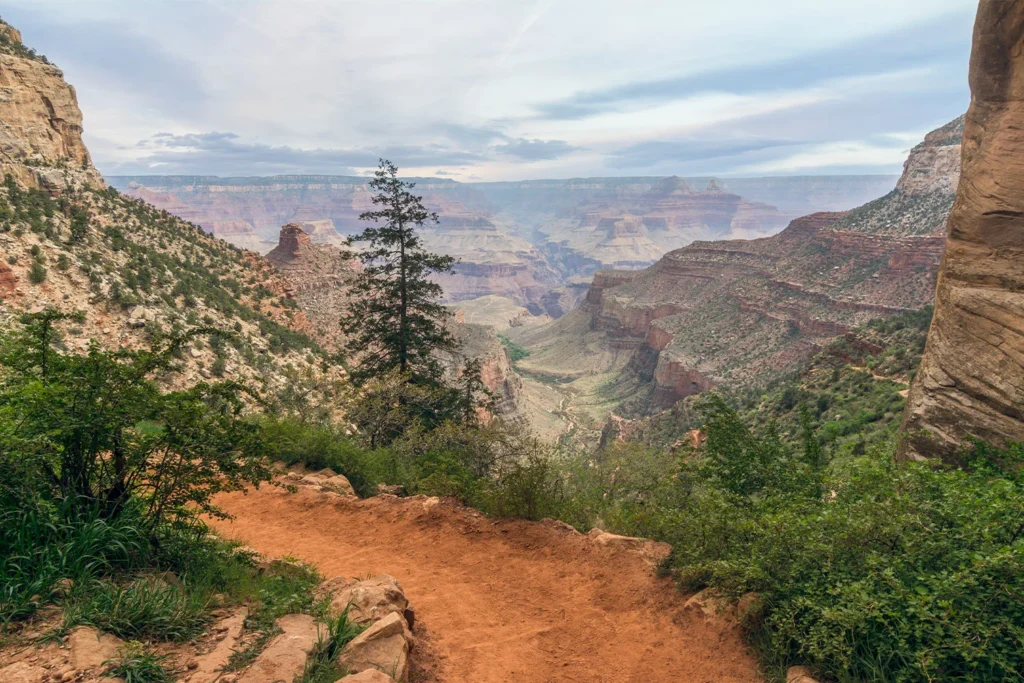
If you’re only planning a short visit to take a few photos and admire the breathtaking landscape of the Grand Canyon, one day might be enough. However, to fully appreciate the park’s many wonders, one day is definitely not enough. You can reserve a stay at one of the hotels within the park or book a campsite if you prefer to camp. Regardless of the type of accommodation you’re interested in, it’s essential to book well in advance, often several months ahead of your trip, due to high demand.
Near Grand Canyon National Park
When you search for “Grand Canyon Colorado” online, you may come across many photos that, while reminiscent of the iconic canyon landscape, are not part of Grand Canyon National Park. One of the most frequently searched attractions in the area is the Skywalk, a glass observation deck shaped like a horseshoe. Built in 2007, this platform extends over 20 meters beyond the canyon’s edge, suspended 1,300 meters above the ground, offering breathtaking views below and making visitors’ hearts skip a beat. It’s important to note that to experience this sky-high walk, you’ll need to head to Grand Canyon West, a reservation managed by the Hualapai Tribe located at the western edge of the Grand Canyon, about 400 km from the South Rim of the National Park.
Another Instagram-famous spot is Horseshoe Bend, where the Colorado River makes a dramatic 270º curve, creating a stunning natural spectacle. This scenic location is part of the Glen Canyon National Recreation Area, located just 8 km from the park’s borders, but about 225 km from the main tourist hubs of the Grand Canyon. Horseshoe Bend is also relatively close to the town of Page, which is worth visiting to explore the awe-inspiring Antelope Canyon.
Practical information
- It is worth booking tickets for Grand Canyon tours in advance. There are many tours available with experienced guides who will show you the most interesting spots, answer questions, and share fascinating facts about the areas being visited.
- Buy a guided tour on GetYourGuide